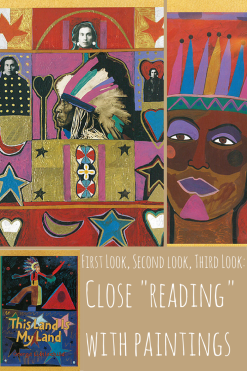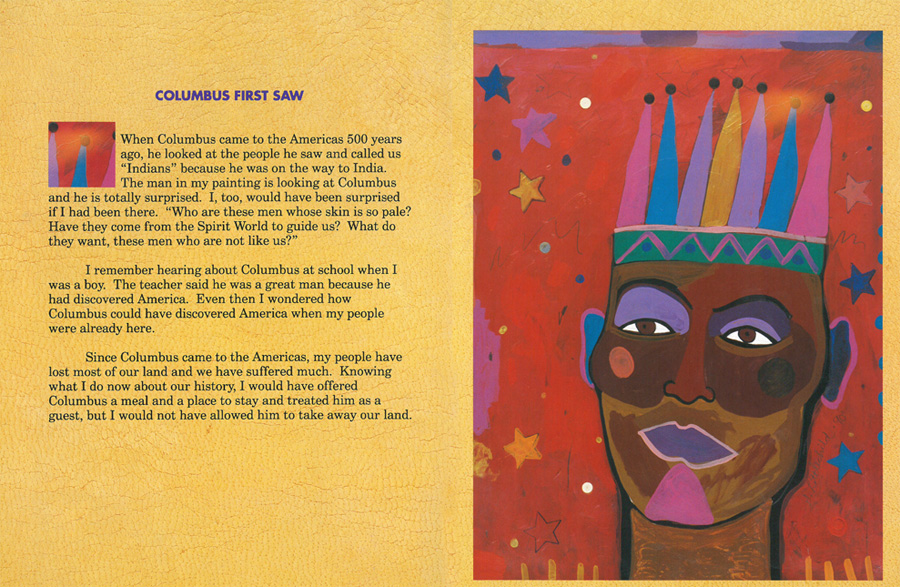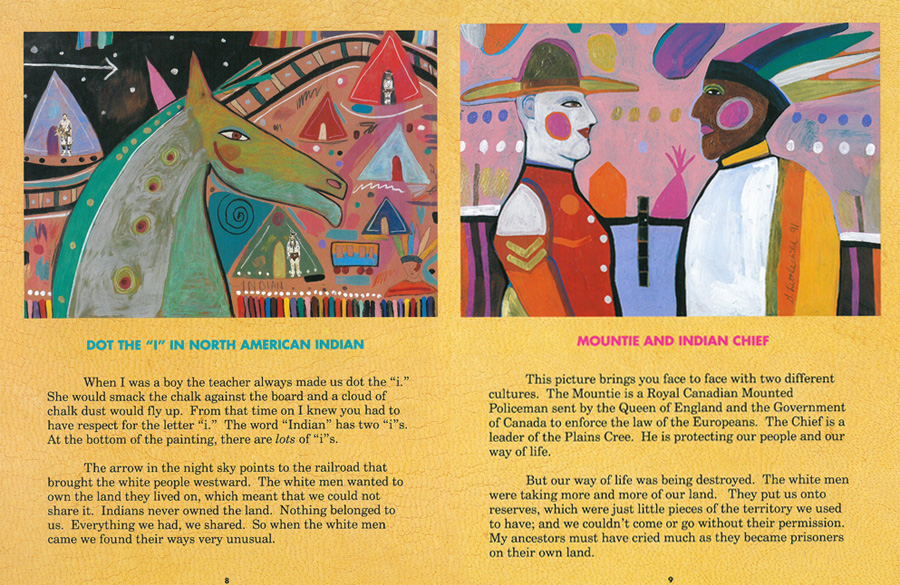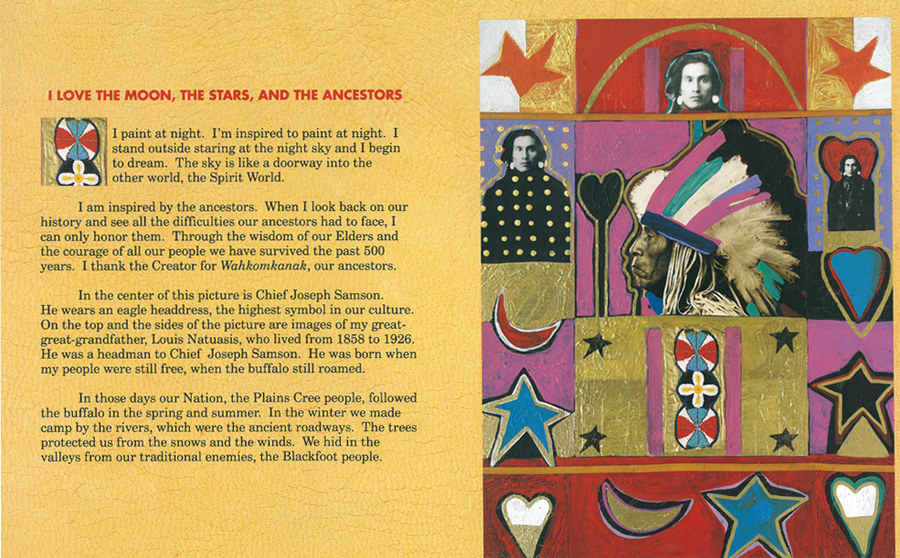new posts in all blogs
Viewing: Blog Posts Tagged with: art education, Most Recent at Top [Help]
Results 1 - 8 of 8
How to use this Page
You are viewing the most recent posts tagged with the words: art education in the JacketFlap blog reader. What is a tag? Think of a tag as a keyword or category label. Tags can both help you find posts on JacketFlap.com as well as provide an easy way for you to "remember" and classify posts for later recall. Try adding a tag yourself by clicking "Add a tag" below a post's header. Scroll down through the list of Recent Posts in the left column and click on a post title that sounds interesting. You can view all posts from a specific blog by clicking the Blog name in the right column, or you can click a 'More Posts from this Blog' link in any individual post.

By: Karen O'Lone-Hahn,
on 9/5/2015
Blog:
Another Side of Karen O'Lone-Hahn
(
Login to Add to MyJacketFlap)
JacketFlap tags:
design,
art education,
frida kahlo,
picasso,
budget cuts,
van gogh,
Steve Jobs,
public schools,
Apple Computer,
genius,
Matisse,
Andy Warhol,
cultural heritage,
art in schools,
great artists,
Mactintosh,
Add a tag
Please forgive me while I stand on my soap box for a bit today.
 |
| I never wear shoes like this but maybe I should :0) |
It's that time of year again. Your kids have either already started back to school or they will be there shortly. Does your child's school still have an art program? More and more schools across the nation are eliminating arts and music programs. If they replace them with anything at all it is sometimes with pseudo art instruction performed by an unqualified classroom teacher.
That statement is not meant to disparage classroom teachers, it is just that they are not trained arts specialists. The major justification for ending arts programs is almost always budget. School districts are constantly complaining that they don't have a enough money for basic programs, so first on the chopping block is usually what administrators and parents see as the most extraneous and unnecessary programs- art and music.
Here are some of the common myths and justifications for deeming art as unnecessary and thereby eliminating it.
Every child is not a talented artist
Every child is not going to be an artist
Training children in the arts has no application to real world (job) success
Art is meant to help children "express themselves"
Here is what arts education really gives to your kids:
The number one most valuable thing that art education provides to your child:
It teaches them to THINK critically and innovate. It teaches them to TAKE RISKS and to see the BIG PICTURE.
Making art is not just about making pretty things or providing some slapdash approach to "self expression" devoid of rules and structure. There are rules in art- Elements and Principals of Design- which provides a framework for making good art and once understood, provides a vehicle for creating good art while breaking those rules and learning to innovate.
Art history provides a cultural framework and point of reference for history and innovation throughout time. Children without skill in creating art are still given an understanding of the cultural heritage of art, get exposed to great thinkers and artistic creators (ex. Picasso, Matisse) who broke from the mold of realistic art making to devise a new way of SEEING and creating.
Art is not always about the end product. The value of art education is more in the processes of creating art and learning about it than in the outcome of making a pretty picture.
Most other disciplines only work on finding right or wrong answers. There is no room for thinking out of the box or for creating a new paradigm. Children who are only being educated in these limiting disciplines will grow to only seek the correct (predetermined) answer, never being able to consider another option and will accept as irrefutable that which is spoon fed to him as fact.
We need to keep raising generations of Picasso's, Da Vinci's, Van Gogh's, Louise Nevelsons and even more Andy Warhol's, whose art was not just pictures of Campbell Soup cans, but a shrewd commentary on our massed produced society as a whole, a concept seen through an artists ability to view "the big picture."
 |
| Louise Nevelson |
 |
| Louise Nevelson- Royal Tide IV-Assemblage |
The world needs both kinds of thinkers, both right brain and left. Here is a perfect example:
Steve Wozniak, a left brain tech head computer guy who, left on his own would probably have had his own small company or gone to work for IBM or Microsoft or Oracle or any other computer giant out there at the time.
Steve Jobs, a hippy dippy, right brain college drop out with an understanding of business,training in art and a devoted sense and love for beauty and good design.
It is the combination of these two very different types of talents that brought us all of the elegant and beautiful Apple computer products which many of us enjoy and other companies try to emulate.
The marriage of these two divergent genius brains resulted in something of a lightening strike which created (in my opinion) one of the greatest tech companies ever.
 |
| Steve Jobs (standing) and Steve Wozniak (at keyboard) |
Is your kid going to be the next Steve Jobs or Picasso or Frida Kahlo? Maybe not. If given the benefit of a meaningful art education, what they can be is a well rounded human being who can think outside of the box, challenge the status quo, consider various answers to the same problem, create something from nothing, use the tools at hand in new ways and make cross cultural and historical connections.
Oh, and they may come home with a nice painting sometimes, too.
 |
| Frida and Me- © Karen O'Lone-Hahn |

By:
jilleisenberg14,
on 11/9/2014
Blog:
The Open Book
(
Login to Add to MyJacketFlap)
JacketFlap tags:
children's books,
literacy,
art education,
Educators,
Native American,
reading comprehension,
close reading,
Educator Resources,
Common Core State Standards,
CCSS,
guided reading,
ELA common core standards,
Add a tag
I’ll admit it: I was looking for a Native American book by a Native American author to write about in light of Thanksgiving and National American Indian Heritage Month as many teachers do this time of year.
 This led me to reread and re-experience the Children’s Book Press treasure, This Land is My Land, by artist George Littlechild. As winner of the 1994 Jane Addams Picture Book Award and 1993 National Parenting Publications Gold Medal, This Land is My Land is a notable treat for students and readers of all ages.
This led me to reread and re-experience the Children’s Book Press treasure, This Land is My Land, by artist George Littlechild. As winner of the 1994 Jane Addams Picture Book Award and 1993 National Parenting Publications Gold Medal, This Land is My Land is a notable treat for students and readers of all ages.
The book features 17 of the artist’s mixed media paintings organized to portray Native American history in North America and Littlechild’s own heritage and childhood. As I studied Littlechild’s paintings and read his accompanying essays about each, I felt as if I were on a gallery walk with my own earbud connected to the artist.
Although this picture book would make a great counterpoint to many Thanksgiving books out there, This Land is My Land is valuable beyond the Thanksgiving-relevant content. It is a great example of how art is a powerful medium for critical thinking development and can be integrated into literacy instruction (not just the assigned art block a couple times a week).

Click on the image to read the text
So, what does close reading (or “looking?”) look like with art?
Like a text, a piece of art is another place for students to engage with multiple times and each time diving into another level of meaning and interpretation. Using art in the classroom relates to the reading standard 7 of the Common Core, Integration of Knowledge and Ideas. Additionally, many of these questions are questions we would use with students in the close reading of a text.
Below is an example of how students can progress with their observations and thinking. I separated levels of questions into three viewings based on level of complexity, but of course one could (and should) return to a worthwhile painting many, many times.

First look (literal comprehension/understanding)
- What is happening?
- What patterns do you see? What images, colors, and symbols do you see repeated or used most often in this painting or across paintings?
- What materials does Littlechild use?
- How does Littlechild use positive or negative space?
- How does Littlechild use the foreground and background?
- Who is the narrator?
- What are some common ideas or events portrayed in his artwork?
- What is the central idea of the painting? What is the central idea of the paintings taken altogether? What makes you think so?
Second look (higher level thinking/interpretation of meaning)
- What effect do repeated colors, images, patterns, or symbols have on his art and the central idea?
- What effect does a specific material, such as shells or sequins, have on his art and the central idea?
- What does “Indian” mean to Littlechild?
- How does Littlechild’s background (childhood, heritage, identity, family relationships) affect the subjects, themes, and materials of his paintings?
- What has Littlechild learned from his elders? What does he want viewers to learn from or think about events in the past and our heritages?
- What is the mood of one piece of the artwork or the collective body of artwork? What makes you think so? What colors, patterns, materials, or images does he use to convey mood?
- What is the purpose of his art? Why would Littlechild create this painting or assemble these paintings into a collection? Why talk about these events and his heritage and childhood at all?
- Who do you think is the intended audience of This Land is My Land? What might Littlechild want them to do with this narrative and perspective?
- How does Littlechild demonstrate pride in and appreciation for his heritage? How does he convey pain in Native American history? How does he convey the closeness of his community?
Third look (higher level thinking/analysis of artist’s craft/structure/methods)
- Why does Littlechild choose to start the book with a dedication to his ancestors and include their photographs?
- How is the collection of paintings organized? How does the chronological structure convey or confirm his central idea? How does this mixed media collection compare to a biography in book form?
- Why does Littlechild choose the title and painting for the book cover: This Land is My Land? He doesn’t like the song, “This land is your land, this land is my land,” or its meaning; so, why does it fit as the title and cover painting for the book? What does this choice tell us about the central idea of the book? What message does he want to convey to viewers?
- Why does Littlechild use photographs in the painting, instead of just drawing the figures? What effect do the photographs have on the story he is telling and on the painting itself? (Repeat this question for feathers, sequins, shells, and feathers)
- Why do you think the artist chooses to use the motif of stars? What do a “star” mean in this context? the number four? horses?
- Why does Littlechild choose art/mixed media collage to represent events in his own life and convey his the central idea?

For further reading on integrating the Arts with the Common Core, check out these fantastic resources:
How are you integrating art with the Common Core? What tips do you have for choosing high quality art to teach? What art are you using already? Let us know!
 Jill Eisenberg, our Senior Literacy Expert, began her career teaching English as a Foreign Language to second through sixth graders in Yilan, Taiwan as a Fulbright Fellow. She went on to become a literacy teacher for third grade in San Jose, CA as a Teach for America corps member. She is certified in Project Glad instruction to promote English language acquisition and academic achievement. In her column she offers teaching and literacy tips for educators.
Jill Eisenberg, our Senior Literacy Expert, began her career teaching English as a Foreign Language to second through sixth graders in Yilan, Taiwan as a Fulbright Fellow. She went on to become a literacy teacher for third grade in San Jose, CA as a Teach for America corps member. She is certified in Project Glad instruction to promote English language acquisition and academic achievement. In her column she offers teaching and literacy tips for educators.
Filed under:
Common Core State Standards,
Educator Resources Tagged:
art education,
CCSS,
children's books,
close reading,
Educators,
ELA common core standards,
guided reading,
literacy,
Native American,
reading comprehension 


Everyone’s creative story is different because we are all unique and completely individual in our own way, meaning nobody’s creative journey is exactly the same. Some of us may know early on that we are destined to be creative and set to pursue our career through college and university, where as there are other people who discover their creative meaning deep down later on like a seed that needed time to grow. Over the years I’ve come across some very talented people, many whom have spent time in art education and some who are purely creatively self taught.
The question that has often come to mind though no doubt for those of you who may have self taught your practice is “does it matter whether you have an art education background or whether you’re self taught?” Many people are going to have mixed opinions on this topic and there are sometimes pros and cons to both, but whether you are self taught or have had the opportunity to study in education here’s my two cents on why I still think you’re creatively amazing whichever path you take.
1. You’ve followed your own creative path in a different way and you should be proud of how far you’ve come and excited of where you’re yet to go.
2. The opportunity for development and learning is endless , there’s no race to the finish in either circumstance so invest in yourself and build on who you are.
3. Don’t think so much that you’ve missed out on opportunities in the past, just look to the future, what you aspire to achieve and have to share.
4. You can draw just as good as the next guy but remeber that like our artwork we’re all works in progress.
5. You’ve got your eye on the end goal and inside have creative idea’s and potential that someone else has yet to imagine.
Image by Artist Fredrik Rattzen you can find out more about their work here .
I just saw this posted on Boing Boing's site and and to repost it. It is a wonderful speech and Laurie Anderson is an amazing speaker. In a way, she says a lot of the things that are said in the Neil Gaiman speech that went viral a couple weeks ago. (I posted it on the Cincinnati Illustrators Blog)
One thing they do not mention in either speech however (and perhaps that would not be the appropriate venue for such commentary) is the crippling amount of student loans that art students have these days (and students in general). It is almost impossible to start a decent art career $40,000 to $100,000 in student loan debt.
Usually as one gets older and further along in their art career, the younger generation is nipping at their heels (as it should be). Now these kids are completely hobbled by this incapacitating debt and it is a shame...
I feel really lucky to have gone to school when I did and it was still affordable. It seems like a number of forces have made that no longer the case and that needs to change.
I am not sure of the solution, but my heart goes out to those just starting out.
Okay. If I'm going to get my five on Friday in, I'm going to have to do it quickly.
1. I'm extremely excited to tell you all that two of my fine artworks have been accepted into a juried show. The first annual Yarmouth Art Festival will take place Oct. 15-17.

Forty-five artists are slated to display and sell their work – including photography, painting, etching, sculpture and digital media – at the inaugural event in the church’s bright, post-and-beam space in a wooded setting about a mile from Cousins Island.
The jurors were Chris Thompson, an associate professor at the Maine College of Art in Portland; and Kevin Tierney of Falmouth, a longtime art enthusiast and founder of the online marketplace www.maineartcollectors.com.
The gallery will be open from 10 a.m. to 7 p.m. Friday, Oct. 16, and from 9 a.m. to 5 p.m. Saturday, Oct. 17. Admission is free each day, with donations accepted. Sponsored by St. Bart’s, the festival will open to the public with an artists’ reception from 6 to 9 p.m. Thursday, Oct. 15, that includes music and refreshments. I'll be there! I hop to see you then.
My piece are: Rhododendron, which is an oil painting,and Patriot Reflected, a pastel.
2. Another oil painting of mine will hang in the Harvest Show and Auction to benefit the Maine Farmland Trust. That show will be in Belfast.
The opening reception for the HARVEST show at Maine Farmland Trust Gallery is set for October 23rd, 5-7pm. The 10th anniversary celebration with the silent auction has been scheduled for November 16th. MFT Gallery, 97 Main St, Belfast ME 04915.
3. I spent an amazing day at the Art Educators conference. My gosh, I didn't realize how lonely I was. (Writing and illustrating is a lonely business.) It was great and I learned a ton from the VSA maine outreach educator. Thank you Rachel!
4. (Ack. I only have 15 minutes until Saturday and 15% power.) My parents are coming to visit this weekend!
5. Hubby comes home tomorrow after 2 weeks of single parenting. Just in time to celebrate our 16th anniversary! Hooray!
There is no point crying over spilt milk right? Then what about crying over weeks and weeks of lost work???
Last week I had decided to finish off and launch a few projects I had spent quite some time on this year. One was an art e-book on Safety for artists, another art book on Artists Pitfalls and how to avoid them and also a whole lot of art teaching material complete with an art teaching web site ready to launch.
Unfortunately a few months back I had difficulty installing and updating my software and I had to save all my documents onto a borrowed external hard drive and reformat my PC. I did this and thought I had transferred everything back BUT not all of it did! Maybe I hit the ’17 hour day/2am and I am tired’ button. Thank goodness I back up my client’s graphics and web sites more than one way.
I am only now discovering what was lost and you guessed it…quite a bit! Oh the hours I spent on those art books! I have searched through all my backup discs and most of my hard copies. I found one other art e-book in hard copy I thought I had lost. At least I can re-type that book but as for the rest; I am still hoping my other art books and art teaching material will magically appear. I have been a brave girl and no tears shed, but as the character Homer Simpson says ‘DOH!”
So for all the people waiting for the first e-book I promised (Artist’s Pitfalls) I apologise.
And what now?
I do have other great material and I will get this moving as quickly as I can.
You can also look forward to an interesting newsletter this month (That is if you have signed up for it!)
I also have some great news to post later this week that will interest any artist wanting to promote their work to a wider audience and make extra income as well. I am very excited about it too as you will be once I tell you so don’t miss that post!
If you are like me and keeping track of things needs to be easy then sign up for my RSS feeds to be notified of my posts as they happen. You don’t want to miss out do you? :-)

By: Kayleen West.,
on 9/3/2007
Blog:
Kayleen West
(
Login to Add to MyJacketFlap)
JacketFlap tags:
free ebooks,
art books,
a painting a day,
afordable art,
art education,
artist life,
art lesson,
free ebooks,
art ebooks,
artist life,
art lesson,
art ebooks,
Add a tag
New FREE e-book on Artists Pitfalls.
As we speak I am finishing off my first free e-book for artists, which covers some of the pitfalls when learning to paint. I hope to launch it on this blog later this week. To make sure you remember to get a copy for yourself subscribe to my Easy Updates via the subscription form on the right panel of this blog.----------------------->
This free e-book will
Wikis’ can be fun. Not always accurate but worth a look. One of the most well known being the Wikipedia.
I came across a How To Wiki today and found some art related articles.You may like to take a look. http://www.wikihow.comHow To Appreciate Michelangelo Buonarroti's PaintingsHow To Appreciate Modern American ArchitectureHow To Appreciate Vincent Van Gogh Art WorkHow To Be Invited to Art











 This led me to reread and re-experience the Children’s Book Press treasure,
This led me to reread and re-experience the Children’s Book Press treasure, 





no no no!! I'm so sorry, Kayleen!
ah bugger! I lost my whole mailing list not long ago.. it still hurts.
Catch up soon. *hugs*
Lauren.
Ah I am ok. There are worse things that happen in this crazy world. Lauren a mailing makes life a bit more difficult though.
I keep telling myself to slow down and BACK UP frequently